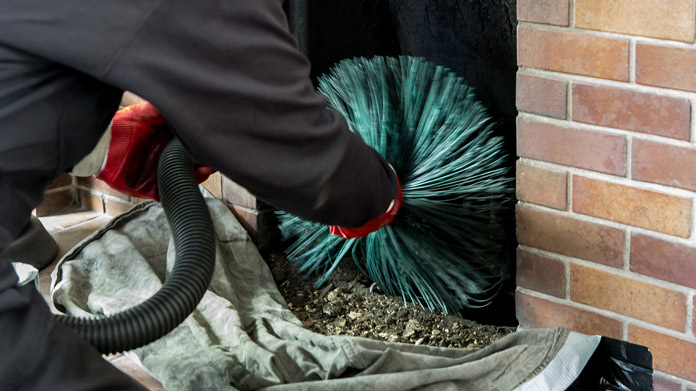Grasping the Art of Chimney Maintenance San Jose: Professional Recommendations and Approaches
Grasping the Art of Chimney Maintenance San Jose: Professional Recommendations and Approaches
Blog Article
Specialist Tips for Effective Smokeshaft Maintenance You Required to Know
Chimneys offer as critical parts in several homes, supplying warmth and comfort. From the relevance of routine examinations to safe operational practices, an extensive method to smokeshaft upkeep is essential.
Value of Regular Examinations
Routine inspections of chimneys are vital for ensuring their safety and security and performance. Smokeshafts play a critical function in airing vent out harmful gases and maintaining proper air movement in a home. In time, creosote buildup, debris, and architectural damage can occur within the smokeshaft, posing significant dangers such as smokeshaft fires or carbon monoxide gas leakages.
During a smokeshaft inspection, trained professionals assess the problem of the smokeshaft, searching for any kind of indicators of damage, blockages, or damage. They additionally inspect the honesty of the flue, chimney liner, and smokeshaft cap to guarantee everything remains in appropriate functioning order. By recognizing and dealing with concerns early, costly repair work or possible hazards can be stayed clear of.
Normal assessments not just help in preserving the safety of the smokeshaft yet additionally add to its general performance. A clean and well-maintained smokeshaft operates better, making sure correct ventilation and decreasing the danger of interior air contamination. Organizing annual chimney evaluations is a positive procedure that house owners can take to shield their property and loved ones.
Cleansing Strategies and Regularity
Keeping the security and effectiveness of a chimney includes not just routine evaluations but additionally executing appropriate cleansing strategies and figuring out the optimal regularity for cleaning. Smokeshafts need to be cleansed by a specialist smokeshaft sweep at the very least as soon as a year, also if they are not frequently made use of. Nonetheless, if the chimney is utilized on a regular basis, particularly with wood-burning ranges or fireplaces, it might need more constant cleanings to avoid the build-up of creosote, an extremely flammable material that can cause chimney fires.
House owners must never ever forget chimney cleaning, as it is important for preserving a practical and secure chimney system. Routine cleanings not only decrease the risk of chimney fires however additionally boost the smokeshaft's general efficiency and long life.
Addressing Smokeshaft Leaks

When attending to chimney leaks, extensive assessment and punctual repair services are important to avoid water damages and keep the structural integrity of the smokeshaft. Leaks in a smokeshaft can lead to severe issues such as mold growth, deterioration of the smokeshaft structure, and also possible fire hazards. To successfully deal with chimney leaks, beginning by inspecting the smokeshaft cap, crown, blinking, and stonework for any indicators of damages or wear. Chimney caps should be safely in position to avoid water from getting in, while the crown and pop over to this web-site flashing should be intact and effectively sealed. Any splits or gaps in the stonework need to be repaired quickly to protect against water seepage. Additionally, consider waterproofing the chimney to give an extra layer of security versus moisture. Routine upkeep and assessments can aid spot and attend to chimney leaks early, saving you from pricey repairs and making sure the safety and security and long life of your smokeshaft.
Understanding Creosote Accumulation
To understand the possible dangers of creosote build-up in chimneys, it is vital to acknowledge its formation procedure and influence on chimney efficiency. Creosote is a black or brownish tar-like substance that gathers inside smokeshaft systems when timber or fossil fuels are shed. As smoke rises via the smokeshaft, it cools and condenses, causing the formation of creosote, which sticks to the chimney wall surfaces.

Routine chimney assessments and cleansings by a professional chimney sweeper are vital in protecting against creosote accumulation and making certain the secure operation of your smokeshaft system.
Safe Procedure Practices
Carrying out correct security methods is vital for the reliable and protected procedure of chimney systems. Always make certain that the chimney is properly examined and cleaned up regularly to eliminate any type of creosote buildup, which can lead to chimney fires.
In addition, ensure to just burn experienced timber in your fire place, as eco-friendly or damp wood can generate even more creosote and cause dangerous smokeshaft blockages. Finally, never ever leave a fire unattended and always make sure the fire is entirely extinguished prior to going to sleep or leaving your house. By adhering to these safe operation methods, you can take pleasure in a cozy and cozy fire while making certain the safety of your home and loved ones.
Final Thought
To conclude, preserving your chimney is important for guaranteeing its security and performance. Routine examinations, correct cleansing techniques, addressing leakages, handling creosote build-up, and adhering to secure procedure practices are key facets of chimney maintenance. By remaining on top of these jobs, you can avoid possible dangers and extend the lifespan of your chimney. It is important to focus on chimney upkeep to keep your home warm and safe throughout the colder months.
Over time, creosote buildup, particles, and structural damages can take place within the chimney, presenting significant threats such as chimney fires or carbon monoxide leakages.
If the smokeshaft is used consistently, particularly with wood-burning stoves or fireplaces, it might call for even more constant cleansings to avoid the build-up of creosote, view it a highly combustible compound that can lead to smokeshaft fires. (Chimney Maintenance San Jose)
To recognize the potential risks of creosote accumulation in chimneys, it is crucial to recognize its formation procedure and influence on chimney efficiency. As smoke climbs through the chimney, it condenses and cools down, leading to the formation of creosote, Continue which sticks to the smokeshaft walls.
Always make sure that the smokeshaft is skillfully evaluated and cleaned frequently to eliminate any type of creosote build-up, which can lead to smokeshaft fires.
Report this page